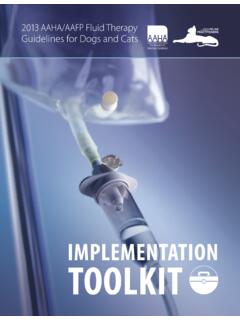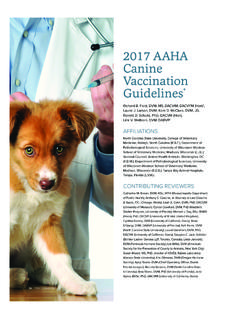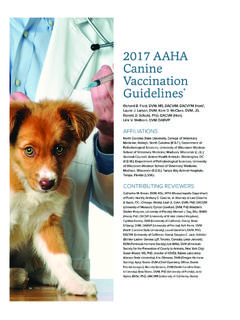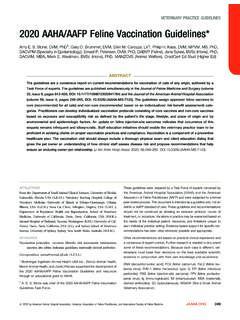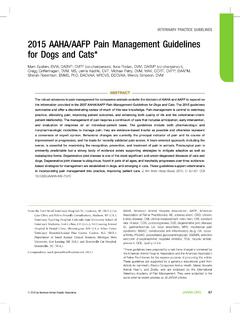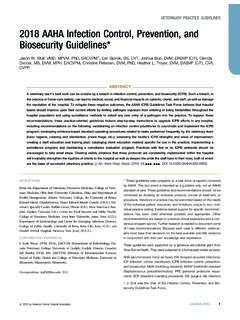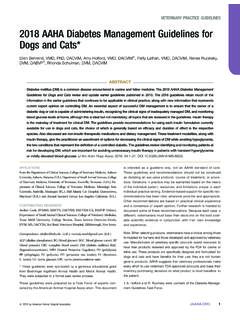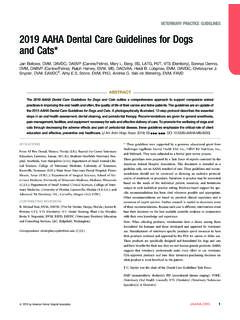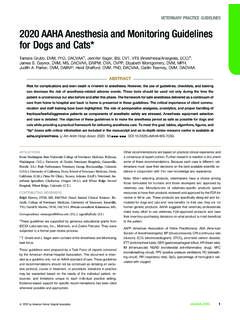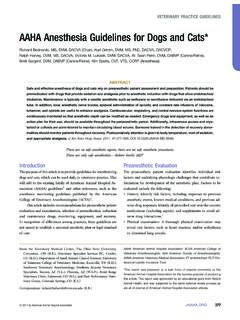Transcription of Intravenous Induction Protocols for Dogs and Cats
1 DrugDose* (mg/kg)CautionComments Dosing ExamplePropofol2 6 Decrease dose by co-inducing with mg/kg of midazolam or diazepamCauses dose-dependent cardiorespiratory depressionFast onset, short duration, so easy to titrate to effect. Repeat dosing is safe in both cats and dogsAlfaxalone1 3 (D)2 5 (C)Fast onset, short duration, easy to titrate to effect. Can be administered IM as a sedative (see sedation chart)Etomidate 1 3 Can cause myoclonus, paddling, and vocalization at Induction but can be prevented with co- Induction with a benzodiazepine. Etomidate with propylene glycol is an irritant to veins, causes pain on injection, and perivascular injections causes tissue necrosis/phlebitis.
2 Can cause adrenocortical suppression use in patients with adrenocortical insufficiency is controversialIdeal choice for patients with significant cardiovascular disease. Causes minimal to no cardiovascular effects but some respiratory depression with rapid IV administration. Can dilute with fluids running to decrease injection pain and vascular effectsThiopental5 15 Will cause tissue necrosis and phlebitis if extravasated; causes respiratory and cardiovascular depressionCurrently unavailable in the USKetamine + Midazolam or Diazepam2 5 used alone causes muscle rigidity and could potentially exacerbate some types of seizures and tachyarrhythmias.
3 These effects are alleviated with the addition of the benzodiazepine. Ketamine is cleared in part unchanged by the kidney in cats so use with caution in cats with renal failureMost commonly administered as a 1:1 ratio by volume using 100 mg/ml ketamine and diazepam or midazolam (5 mg/ml) with an anticipated total dose of 2 ml/ 20 kg IV in a non-or lightly sedated patient and 1 ml/20 kg IV in a moderately sedated patientA lightly sedated 20 kg patient would receive 1 ml diazepam + 1 ml ketamine combined in the same syringe for administrationKetamine + Propofol2 42 4 Same as each drug used individually.
4 May decrease adverse effects of each drug ( , less propofol-induced respiratory depression, less ketamine-induced muscle rigidity)Combine 2 4 mg/kg of each drug (ketamine 100 mg/ml + propofol 20mg/ml) in the same syringe and dose at 2 4 mg/kg of the COMBINATIONFor a 20-kg dog, draw up 40 mg (2 mL) propofol and 40 mg ( mL) ketamine. The combination concentration is 80 mg/mLTiletamine and Zolazepam 1 4 Without the concurrent use of sedatives, can cause prolonged, rough, or dysphoric recovery, especially in dogs. Tiletamine has the same cautions as ketamine and same alleviation of adverse effects because it is combined with a benzodiazepinePhysiologic effects similar to those of ketamine + midazolam or diazepamThese dosages are for a sedated patient.
5 Dosages as high as 6 9 mg/kg may be necessary without sedation Administer one of the drugs or drug combinations as deemed appropriate for any underlying comorbidity. After sedation is achieved, titrate Induction drug to effect, anticipating use of the lower end of the dose range for moderately sedated animals or those with moderate systemic disease. A dose lower than that listed may be adequate for heavily sedated, obtunded, severely diseased patients, neonates and true geriatrics ( , those showing age-related changes). Use caution in patients with inadequate sedation, as this may necessitate a higher dose, which could lead to more physiologic complications.
6 * Dosages are the same for both dogs (D) and cats (C) unless otherwise Induction Protocols for Dogs and CatsChoosing an ideal IV Induction protocol is one of the many decisions required for a smooth anesthetic event. Review these combinations and consider which might be the most beneficial for each patient. The 2020 AAHA Anesthesia and Monitoring Guidelines for Dogs and Cats are available at document is intended as a guideline only, not an AAHA standard of care. These guidelines and recommendations should not be construed as dictating an exclusive protocol, course of treatment, or procedure.
7 Variations in practice may be warranted based on the needs of the individual patient, resources, and limitations unique to each individual practice : The authors, reviewers, and editors of this material have made extensive efforts to ensure that treatments, drugs, and dosage regimens are accurate and conform to the standards accepted at the time of publication. However, constant changes in information resulting from continuing research and clinical experience, reasonable differences in opinions among authorities, unique aspects of individual clinical situations, and the possibility of human error in preparing such an extensive text require that the reader exercise individual judgment when making a clinical decision and, if necessary, consult and compare information from other sources.
8 In particular, the reader is advised to check the drug s product insert before prescribing or administering it, especially if the drug is unfamiliar or is used infrequently.
